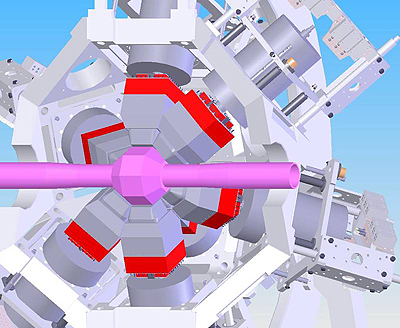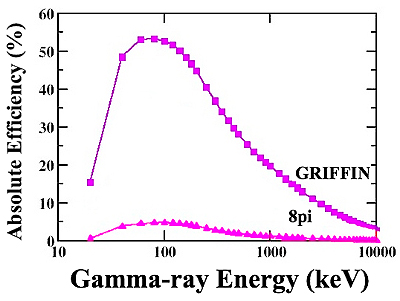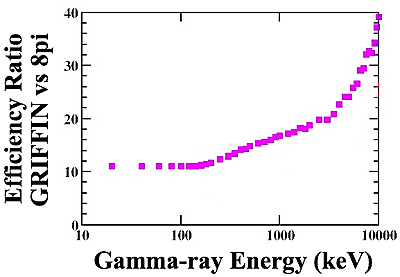This past Tuesday, the GRIFFIN collaboration of TRIUMF, the University of Guelph, Simon Fraser University, Saint Mary’s University, Université de Montréal, and other members met here at TRIUMF to discuss the final details and formally launch the project. GRIFFIN – Gamma-Ray Infrastructure For Fundamental Investigations of Nuclei – will be a high-efficiency gamma-ray spectrometer (an instrument used for detecting and measuring gamma radiation). The detector consists of an array of 16 Hyper-pure germanium clover detectors with a fully digital data acquisition system. The crystals are arranged in a clover configuration, meaning that sets of 4 coaxial germanium crystals are machined to specific shapes and mounted in a common cryostat to form a structure resembling a four-leaf clover. GRIFFIN will replace the germanium (Ge) and data acquisition (DAQ) aspect of the 8pi, and will take advantage of the powerful suite of ancillary detectors that have been developed. These include; the Moving Tape-system for temporal separation/optimization of the particular decay of interest, SCEPTAR (SCintillating Electron-Positron Tagging ARray) for coincidence tagging of beta particles, PACES (Pentagonal Array for Conversion Electron Spectroscopy) for high-resolution measurements of internal conversion electrons, and DANTE (Di-Pentagonal Array for Nuclear Timing Experiments) for fast-timing measurements of gamma rays. GRIFFIN has also been designed to be fully compatible with the new DESCANT array – Deuterated Scintillator Array for Neutron Tagging – also being completed at the University of Guelph. This addition will allow the sensitive study of beta-delayed neutron emission. Since it will have a more advanced state-of-the-art digital data acquisition system, the GRIFFIN facility will allow many experiments to collect much more data within a single beamtime period than has been possible in the past, making the most of the beams available at ISAC. Between the higher detection efficiency and improved data acquisition system, GRIFFIN will allow scientists to look further into the neutron-rich isotopes produced by the Actinide targets at ISAC. The gamma-ray detection efficiency of GRIFFIN will be much higher in relation to the 8pi Spectrometer that has supported the decay spectroscopy research programs at ISAC-I for over 10 years. GRIFFIN is designed for decay spectroscopy, the study of the radiation emitted when radioactive nuclei decay. It will be used for research with the low-energy rare-isotope beams produced at TRIUMF's ISAC-I. This project will support a broad spectrum of research in three major fields: in nuclear structure, it will help understand the properties of nuclei and how these properties change with varying numbers/ratios of protons and neutrons; in nuclear astrophysics, it will look at features of nuclei along the r-process path (thought to be the mechanism for how the heavy chemical elements are formed in the universe); and in fundamental symmetries, performing precision studies of super-allowed fermi beta decays in a particular subset of nuclei that have the same number of protons and neutrons, as well as measurements for the Radon Electric Dipole Moment (Rn EDM) program at ISAC. Professor Carl Svensson from the University of Guelph and TRIUMF’s Adam Garnsworthy are the Co-Principal Investigators for the project. Under the supervision of Carl Svensson, students at the University of Guelph have been developing detailed simulations of the performance of the GRIFFIN detectors. At TRIUMF, Chris Pearson of the DAQ group will be leading the effort to develop and implement the new data acquisition system, which will be based on custom digital-electronics modules designed and built by another collaborator, Jean-Pierre Martin of the Université de Montréal. Extensive conceptual design work of the support structure and infrastructure has been completed at TRIUMF and the detailed design effort will continue in the TRIUMF design office later this year. Once the Hyper-pure Germanium detectors begin to arrive they will be fully tested and characterized in the laboratories of Simon Fraser University, under the supervision of Professors Kris Starosta and Corina Andreoiu. At this time, the project has received $8.7M in funding through the Canadian Foundation for Innovation (CFI), TRIUMF and the University of Guelph. Currently the team is working towards installation of the facility in ISAC I during 2014, with the first experiment being conducted towards the end of that year. In the next few years, the University of Guelph machine shop along with TRIUMF's machine shop and electronics shops will play their parts in making the GRIFFIN facility a reality and enabling a strong future of exciting world-class science here at TRIUMF. -- Written by Lindsay Davies, Communications Student |
A schematic of one hemisphere of the GRIFFIN gamma-ray spectrometer in its maximun efficiency configuration
Absolute efficiency of the 8pi and GRIFFIN Spectrometers at ISAC-I as a function of gamma-ray energy
Ratio of the efficiency of GRIFFIN to the current 8pi Spectrometer. GRIFFIN is 17 times more efficient in gamma-ray singles (almost 300 times more efficiency for gamma-gamma coincidences) at 1 MeV, and around 40 times more efficient by 10 MeV, than the current 8pi Spectrometer |
Canada's particle accelerator centre
Centre canadien d'accélération des particules
Centre canadien d'accélération des particules



